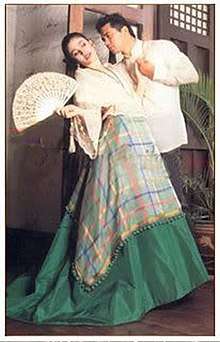Cariñosa
Cariñosa (Spanish pronunciation: [kaɾiˈɲosa], meaning the loving or affectionate) is a Philippine dance of colonial era origin from the Maria Clara suite of Philippine folk dances, where the fan or handkerchief plays a instrumental role as it places the couple in romance scenario.

History
The dance originated in Panay Island in the Visayan Islands and was introduced by the Spaniards during their colonization of the Philippines. It is related to some of the Spanish dances like the bolero and the Mexican dance Jarabe Tapatio or the Mexican Hat Dance.
Bicolano Cariñosa
According to the book of Francisca Reyes-Aquino, Philippine Folk Dances, Volume 2, there is a different version of the dance in the region of Bicol. In the Bicol Region Cariñosa, hide and seek movement is different ways. In the original version, the dancers used the Fan and handkerchief as the way to do the hide and seek movement, in Bicol they used two handkerchiefs holding the two corners of the handkerchief and doing the hide and seek movement as they point their foot forward and their hands go upward together with their handkerchiefs following the movement. It is a complicated step however it is still used in Bicol Region during festivals and social gatherings.
Costume
Originally, the Cariñosa was danced with María Clara dress and Barong Tagalog for it is a María Clara Spanish Dance when it was introduced. In addition, Filipino wore the patadyong kimona and camisa de chino to reveal nationalism. (a native dress of the Tagalog regions), camisa (a white sleeve) or patadyong kimona (a dress of the Visayan people) and for boys, a barong Tagalog and colored pants. Because it is the national dance, the dancers may wear any Filipino costume.
